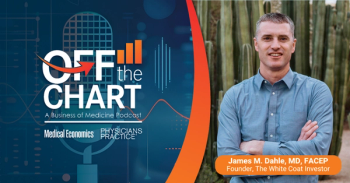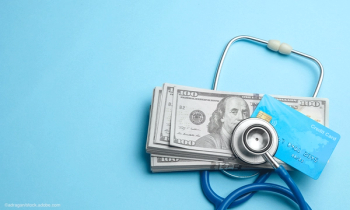
Tackling Med School Debt
Here's how to figure out which payback plan will work for you
Emergency medicine physician Pierce Hibma's talent on the basketball court earned him a scholarship for undergraduate school at Creighton University, where he scored more than 300 career points for the Bluejays.
He also won several student-athlete awards for his academic success and is now a fourth-year medical student at Creighton.
Grateful for the undergraduate scholarship, Hibma nevertheless will leave the university with a substantial med school tab. Counting his wife's graduate school debt, the couple is faced with nearly $400,000 to repay.
"In fleeting moments I've re-thought my career decision," says Hibma, who has been applying for emergency medicine residencies. "It would be nice to just get a job with little or no debt. But I always come back to medicine in the end. I just tell myself it will all work out."
Rebounding from six-figure debt on a relatively modest resident salary is challenging for any young doctor, but new repayment programs are helping new docs repay their loans without starving during the process, experts say.
Repayment programs
The newest programs, income-based repayment plans, aim to keep student loan payments to 15 percent of discretionary income, as defined by the difference between adjusted gross income and the poverty measurement for a similar-size household.
Stafford, Plus, and other consolidation loans are eligible to be repaid under an income-based plan. Exceptions include loans already in default or Parent Plus loans.
In October, the Obama Administration issued an executive order that changed the calculation from 15 percent to 10 percent beginning this year, two years ahead of schedule. The order also cuts the payback period from 25 years under income-based repayment to 20 years, after which the remainder is forgiven.
The changes affect only loans made this year, in 2012, and later, so the old formula applies to borrowers who were already in the system last year.
Under the 15 percent formula, a family of three earning $100,000 with $200,000 in qualifying debt would have a monthly payment of about $905, according to the U.S. Department of Education, which
At $70,000 in adjusted gross income, the maximum monthly payment for a family of four would be $456. With one to seven family members, the range of maximum payments is $671 down to $241, according to the department.
Hibma says he is leaning toward this type of payback plan rather than deferring payments until after residency, known as forbearance.
Deferring loans/forbearance
Deferring your school loans entirely through residency is still an option, but the deferrals no longer freeze interest accruals, and that can get costly, notes Mark Kantrowitz, publisher of Finaid.org and author of "Secrets to Winning a Scholarship."
Despite the recent easing of terms on income-based plans, Kantrowitz expects further tightening of aid programs as the government continues to look for ways to reduce the federal deficit.
"Subsidized interest for undergrads could go away and we expect to see a tightening of eligibility for the Pell Grant program," he says.
Even so, physician salaries are still expected to stay strong enough to handle large debt loads, says Julie Fresne, director of student financial services for the Association of American Medical Colleges.
Median debt among 2011 graduates was $162,000, according to the association.
For someone with a $170,000 starting salary, an income-based plan would take 15 years to pay off, for a total cost over the life of the loan of $308,000.
Under forbearance during residency and then 28 years of payments, the same initial debt would grow to $453,000 in total payments, the AAMC says.
There are some more creative options, particularly for doctors willing to work in nonprofit facilities and underserved areas, says Fresne.
"The National Health Service Corps can be a wonderful way to repay loans," she says. "These programs are competitive, but can make a huge difference for those going into primary care."
A doctor with the same $162,000 in federal loans who chose forbearance during residency and worked under the NHSC program for two years would see total payments drop to $241,000, the AAMC says.
Examining other options
Another option is to combine public service with the income-based repayment plan, Fresne says. Rather than a 20- or 25-year repayment period, the time period is 10 years, after which the remainder is forgiven.
The NHSC offers programs nationwide, typically with a two-year minimum service commitment. The Indian Health Service provides up to $20,000 a year in loan repayment.
"Evidence shows an overwhelming number of physicians are in fact paying off their debt in a timely manner, but it's incredibly important to have a strategy," Fresne says.
One way to be sure you're choosing the right one is to look for (or ask financial aid counselors at your medical school) the downside in any given payment plan, experts say.
For example, an income-based plan can be a lifeline to cash-strapped residents, but using one can also mean you'll pay more in interest over time. So if you have the cash, a traditional payback period with higher monthly payments might make more sense.
A public service commitment can save you money in the short run, but if it means you aren't practicing in the type of environment you desire, the long-term implications can be dire on both your income and your career satisfaction level.
But keep in mind that a public service job won't necessarily mean heading for Alaska or another remote locale. Nonprofit, military, and tribal organizations can all qualify as public service organizations, experts say.
Meanwhile, Hibma says he tries not to worry too much about the potential choices and whether his future salary will make it all worthwhile.
"At one point I started breaking down the debt by the day," he says. "Every day I wake up and go to class it costs me about $200, and I've never had a job in my life where I made that much."
Janet Kidd Stewart is a freelance writer based in Marshfield, Wis. She holds a bachelor's degree and master's degree from the Medill School of Journalism at Northwestern University. She can be reached at
This article originally appeared in the February 2012 issue of Physicians Practice.
Newsletter
Optimize your practice with the Physicians Practice newsletter, offering management pearls, leadership tips, and business strategies tailored for practice administrators and physicians of any specialty.




